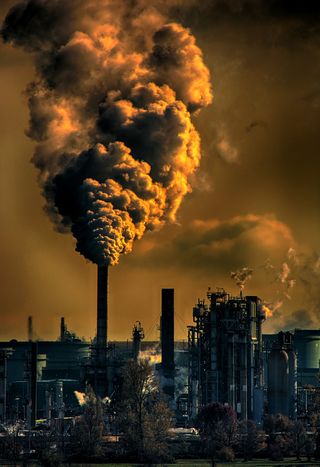Health
Why Don't We Respond to Pollution the Way We Do to COVID?
Why societies respond urgently to one health crisis but not the other.
Posted April 25, 2020 Reviewed by Matt Huston
The COVID-19 pandemic has led to unprecedented governmental lockdown measures that severely limit people’s freedom. The pandemic therefore takes a heavy toll on happiness, employment, and financial security. Despite being painful, most citizens appear to support these measures. Therein lies a paradox: Why do societies not respond with similar urgency to outdoor air pollution?
In terms of raw statistics, we have every reason to take outdoor air pollution as seriously as COVID-19. Estimates by the World Health Organization (WHO) indicate that 4.2 million people die prematurely each year as a consequence of outdoor air pollution. A large portion of the world population lives in places where outdoor air pollution levels exceed WHO limits. These facts are well known, yet societies have been slow to respond.

Certainly, there have been “green” initiatives throughout the years, such as electric cars, sustainable energy sources, and emission caps. But the urgency that societies have displayed to reduce air pollution is nowhere near the immediate and drastic measures to contain the coronavirus. What explains this health crises paradox? Here, I propose that COVID-19 is more likely than air pollution to elicit two emotions that are necessary to stimulate a sense of urgency, namely empathy and anxiety.
An observation relevant for empathy is that COVID-19 yields identifiable victims. When a person tests positive for COVID-19 and subsequently dies of the infection, there is no ambiguity about the cause of death. Air pollution, in contrast, increases the likelihood of other diseases—mostly cardiovascular diseases, but also respiratory infections and cancer. The link with air pollution can be inferred from research relating the prevalence of these diseases to ambient air quality; but it is difficult to establish if, and to what extent, air pollution contributed to the death of a specific person.
People dying from COVID-19 hence have a face, while people dying from air pollution are part of a statistic. This relates to a phenomenon in psychology called the ‘identifiable victim effect’: The visible suffering of a victim produces more empathy than cold statistics of large groups of victims experiencing similar suffering (Small & Loewenstein, 2003). Such empathy is required for compassion and a willingness to sacrifice one’s immediate self-interests for the sake of the victims.

Such visible suffering also contributes to anxiety. People have vivid images of COVID-19 victims who need to breathe through ventilators and realize all too well that they could be next. Relatedly, people are confronted with news of overcrowded intensive care units and mortuaries, as society was unprepared for the pandemic. But while people may also have vivid images of people suffering from cardiovascular disease or cancer, the link with air pollution is less obvious. Moreover, under normal circumstances, hospitals and mortuaries are prepared for the death tolls of these diseases.
Another important difference between COVID-19 versus outdoor air pollution is their future orientation. If people get infected with the coronavirus, they can change from a healthy into a deceased person within the scope of two to three weeks. The adverse health consequences of outdoor air pollution may take decades to become apparent. People thus perceive COVID-19 as a health threat in the near future and air pollution as a health threat in the distant future.
Generally speaking, people experience the near versus distant future differently: The near future is concrete, while the distant future is abstract (Trope & Liberman, 2003). Consider for instance the goals that people set. For the near future, people make specific plans such as buying groceries (and don’t forget the milk), going to the gym (this time for real), and going on a date (but don’t kiss yet). For the distant future, people’s goals involve broader questions such as what career path to pursue, whether to marry and have children, whether to move abroad, and so on.

This has implications for how people feel about both health crises. What scares you more: The concrete possibility of dying within the next two to three weeks, or the abstract likelihood of dying sometime within the next 40 years? Most people would find imagining death scarier for the near than distant future. But gradual and sudden death can cost an equal number of years. A person could die at age 70 instead of 80 as a result of a COVID-19 infection, or as a result of having lived in polluted air for the past decades.
COVID-19 hence has a stronger potential than air pollution to elicit feelings of empathy and anxiety. Interestingly, these two health crises appear to be related: Across the globe outside air quality is improving due to a decrease in cars, airplanes, and industrial activity. Perhaps experiencing what clean air tastes like might install some urgency in the response to this other major health crisis as well. Because in the end, people dying of air pollution are also more than a statistic.
References
Small, D. A., & Loewenstein, G. (2003). Helping a victim or helping the victim: altruism and identifiability. Journal of Risk and Uncertainty, 26, 5-13.
Trope, Y., & Liberman, N. (2003). Temporal construal. Psychological Review, 110, 403-421.




